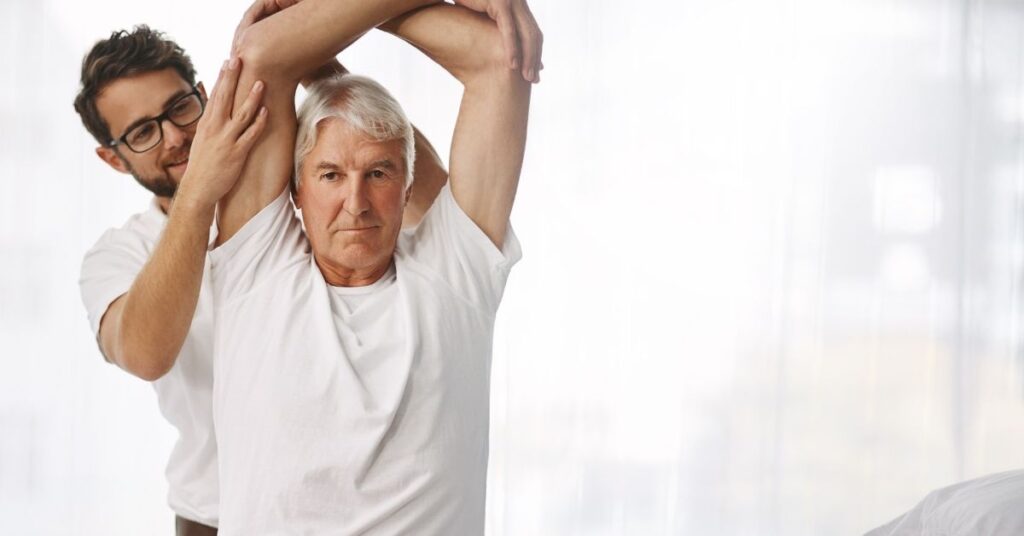Lymphedema can feel like carrying an extra weight you didn’t sign up for. That swollen arm or leg isn’t just a visual change—it can slow you down, make simple tasks more challenging, and leave you rethinking how you move through the world. For those dealing with this condition, mobility isn’t just about getting from point A to point B; it’s about maintaining independence and quality of life. How does lymphedema impact the way you move, and what can you do to keep going? This article examines the relationship between lymphedema and mobility, offering practical guidance and encouragement for maintaining an active lifestyle.
What Is Lymphedema?
Lymphedema happens when the lymphatic system, your body’s drainage network, gets blocked or damaged. Fluid builds up, causing swelling in areas such as your arms, legs, or torso. It’s often tied to cancer treatments, like lymph node removal or radiation, but can also come from injuries, infections, or genetic conditions. The swelling isn’t just puffiness—it can feel heavy, tight, or even painful, changing how you use that part of your body.
Imagine trying to lift a grocery bag with an arm that feels like it’s weighed down by water. That’s lymphedema for many people. It’s not just a cosmetic issue; it affects how you walk, reach, or even sit comfortably. Understanding this condition is the first step to tackling its impact on mobility because when you know what you’re dealing with, you can find ways to work around it.
How Lymphedema Impacts Mobility
Lymphedema doesn’t just sit there—it messes with your ability to move freely. A swollen limb can feel like a foreign object, throwing off your balance and coordination. For some, it’s a mild annoyance; for others, it’s a daily barrier. The degree of impact depends on the severity, location, and duration of the swelling. Let’s break down how this condition gets in the way of moving your body.
The weight of a swollen leg or arm adds resistance to every step or lift. It’s like wearing a heavy boot you can’t take off. Joints may stiffen, making bending or stretching more difficult. Over time, this can weaken muscles, as you instinctively avoid using the affected limb. One woman I heard about stopped gardening because her swollen arm made digging too painful. These changes aren’t just physical—they can chip away at your confidence to stay active.
Balance and Coordination Challenges
Swelling throws off your body’s symmetry. A swollen leg may cause you to limp, increasing the risk of trips or falls. This is especially true for older adults, who may already struggle with balance. Even simple tasks, like climbing stairs or getting out of a chair, can feel daunting when one limb doesn’t cooperate. The brain has to work harder to compensate, which can be physically and mentally exhausting. It’s not just about moving—it’s about driving safely.
Fatigue and Reduced Endurance
Lymphedema is tiring. Carrying extra fluid weight burns more energy, so you may feel exhausted after a short walk. This fatigue can discourage exercise, creating a cycle where less movement leads to weaker muscles and worse swelling. One man described how his swollen leg made a 10-minute stroll feel like a marathon. Breaking this cycle is crucial to maintaining mobility, but it requires a strategic approach and support.
Why Mobility Matters
Mobility isn’t just about physical function—it’s about living your life. Being able to walk to the mailbox, play with your kids, or run errands without pain keeps you independent. For lymphedema patients, losing mobility can feel like losing a piece of who they are. It’s not just about getting around; it’s about staying connected to the things that matter.
When mobility takes a hit, mental health often follows. Avoiding activities due to discomfort or fear of falling can lead to isolation or frustration. One patient shared that she stopped attending her book club because standing for long periods made her legs ache. Preserving mobility isn’t just about the body—it’s about protecting your emotional well-being and social life, too.
Factors That Worsen Mobility Issues
Not all cases of lymphedema affect mobility in the same way. Several factors can make things tougher. The stage of lymphedema is a big one—early-stage swelling (Stage 1) is easier to manage than severe fibrotic swelling (Stage 3). Location matters, too; a swollen leg impacts walking more directly than a swollen arm. Other health conditions, such as arthritis or obesity, can exacerbate the problem, adding strain to already compromised limbs.
Lifestyle plays a role as well. Sitting or standing for long periods can worsen swelling, stiffening joints, and slowing you down. Delaying treatment is another culprit—untreated lymphedema progresses, making mobility harder to regain. Understanding these factors helps you and your healthcare team identify the most effective solutions.
The Role of Infections
Infections like cellulitis pose a serious risk with lymphedema and can significantly impair mobility. Swollen tissue is prone to bacterial infection, and an infection can cause redness, heat, and further swelling, making movement painful or impossible. One guy I read about was bedridden for a week after a cellulitis flare-up, losing ground on his physical therapy. Preventing infections through proper skin care and early treatment is crucial for maintaining mobility and overall well-being.
Strategies to Improve Mobility
The good news? You can manage lymphedema in ways that not only protect but also improve your mobility. It’s not about a quick fix—it’s about consistent, wise choices that add up. From therapy to lifestyle adjustments, here’s how to stay active with lymphedema.
Complete Decongestive Therapy (CDT)
CDT is the cornerstone of lymphedema treatment, combining manual lymph drainage, compression, exercise, and skincare. Manual lymph drainage, a specialized massage, moves fluid out of swollen areas, lightening the limb and easing movement. Compression garments or bandages keep swelling in check, supporting joints and muscles during activity. One patient said her compression sleeve made lifting her arm feel “normal again,” allowing her to return to yoga.
Exercise in CDT is tailored to your needs—think gentle stretches or walking, not high-intensity workouts. These movements boost lymph flow and strengthen muscles without overloading the body. Skincare prevents infections that could sideline you. A trained lymphedema therapist guides this process, ensuring every step supports mobility.
Low-Impact Exercise
Exercise is essential, but it must be the right kind. High-impact activities, such as running, can exacerbate swelling, but low-impact options offer a better alternative. Swimming is a superstar—water’s buoyancy reduces strain while providing natural compression. Yoga and tai chi enhance flexibility and balance, enabling you to move with greater confidence. One woman found that pool walking reduced her leg swelling enough to allow her to climb stairs without pain. Start slowly and work with a physical therapist to see what works for you.
Aquatic Therapy
Aquatic therapy deserves its spotlight. In a warm pool, your body feels lighter, and the water pressure acts like a gentle compression garment. This makes it easier to move swollen limbs without discomfort. Sessions might include arm swings, leg kicks, or walking against water resistance, all designed to boost mobility. A man with leg lymphedema said that aquatic therapy allowed him to “move like I used to,” rebuilding his stamina. It’s a low-risk way to stay active, especially for those with severe swelling.
Assistive Devices and Modifications
Sometimes, mobility needs a little extra help. Assistive devices like canes or walkers can stabilize you if a swollen leg affects balance. Custom orthotics or supportive shoes ease pressure on swollen feet. At home, small changes—like adding a shower chair or elevating furniture—make daily tasks less taxing. One patient installed grab bars in her bathroom, giving her confidence to move without fear of slipping. These tools aren’t about giving up—they’re about staying independent.
Weight Management
Carrying extra body weight puts more strain on swollen limbs, making movement more challenging. A balanced diet with reduced salt intake can help reduce fluid retention, while gradual weight loss eases pressure on joints. It’s not about drastic diets—small changes, like swapping processed snacks for veggies, help. A nutritionist can tailor a plan that supports lymphedema and mobility goals. One man lost 15 pounds and noticed that his swollen leg felt lighter, allowing him to walk farther.
The Emotional Side of Mobility Challenges
Lymphedema’s impact on mobility isn’t just physical—it also affects your emotions. Frustration is common when you can’t do what you used to, whether it’s hiking or playing with grandkids. Self-consciousness about a swollen limb may make you avoid public spaces, further limiting your activity. These feelings can spiral, making it harder to stay motivated.
Talking to a counselor or joining a support group can help. Sharing your struggles with others who get it—like how hard it is to tie shoes with a swollen hand—lightens the load. One woman discovered that a lymphedema forum offered her valuable tips and encouragement to stay active. Acknowledging the emotional side isn’t a weakness; it’s part of the fight to keep mobile.
Building Confidence to Move
Confidence is a significant factor in mobility. Fear of falling or worsening symptoms can make you hesitant to exercise or even leave the house. Physical therapy builds strength and balance, but mental work is just as key. Visualization—picturing yourself walking smoothly—can boost courage. A therapist might start with small goals, such as walking to the kitchen without pain, to help rebuild trust in your body. Every step forward counts.
Working with Your Healthcare Team
A strong healthcare team is your ally. Lymphedema specialists, physical therapists, and even occupational therapists can tailor a mobility plan. They’ll assess your swelling, strength, and daily needs to recommend therapies or devices. Regular check-ins catch issues early, such as a garment that’s too tight or an infection that’s brewing. If your team isn’t clicking, don’t settle—find providers who listen. One patient switched therapists and finally received a plan that allowed her to dance at her daughter’s wedding.
Advocating for Yourself
You know your body best, so speak up. If a treatment isn’t helping or an exercise feels uncomfortable, please notify your team. Bring notes to appointments to stay focused—maybe you’ve noticed more stiffness after standing all day. Self-advocacy ensures your mobility plan fits your life, not just a textbook. It’s about partnering with your providers, not just following orders.
Looking Ahead
Lymphedema research is advancing, with new therapies, such as lymphatic surgeries and advanced compression technology, on the horizon. These could make mobility easier in the future. For now, combining proven treatments with a proactive mindset helps you stay on track. It’s not about erasing lymphedema—it’s about living well despite it.
Conclusion
Lymphedema can challenge your mobility, but it doesn’t have to define it. With the right strategies, such as CDT, low-impact exercise, aquatic therapy, and emotional support—you can continue to move, stay independent, and live a whole life. It’s about small, steady steps, not overnight miracles. Whether you’re aiming to walk farther or just feel better in your skin, you’ve got options. Got questions? Here are some answers to guide you.
FAQs
Q1: How does lymphedema affect mobility?
It causes swelling that adds weight to limbs, stiffens joints, and throws off balance, making walking, lifting, or bending harder.
Q2: Can exercise help with lymphedema and mobility?
Yes, low-impact exercises like swimming or yoga boost lymph flow, strengthen muscles, and improve mobility without worsening swelling.
Q3: What is the most effective way to manage lymphedema for improved mobility?
Work with a lymphedema therapist to undergo Complete Decongestive Therapy, which includes compression and tailored exercises, to reduce swelling and improve mobility.
Q4: Can assistive devices help with mobility issues related to lymphedema?
Absolutely. Canes, walkers, or supportive shoes can help stabilize you and reduce strain, allowing you to stay active safely.
Q5: How can I stay motivated when lymphedema limits my mobility?
Set small goals, join a support group, and talk to a counselor to address emotional barriers. Celebrating progress keeps you going.





